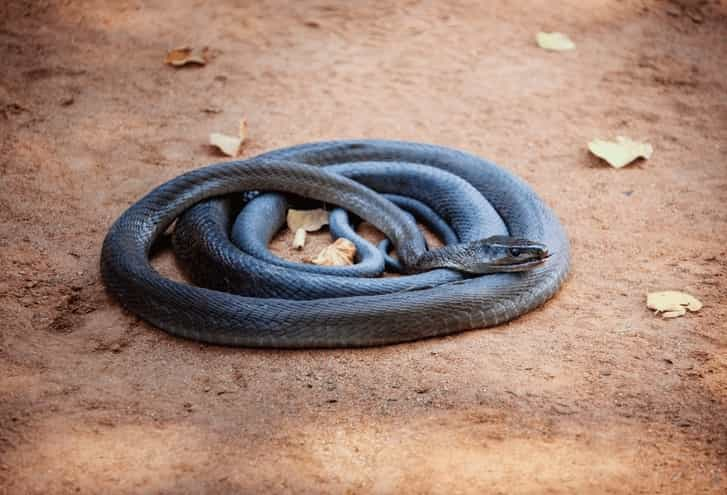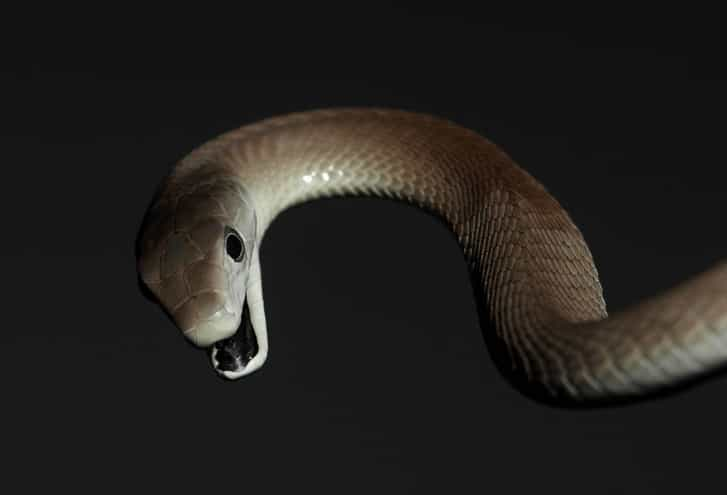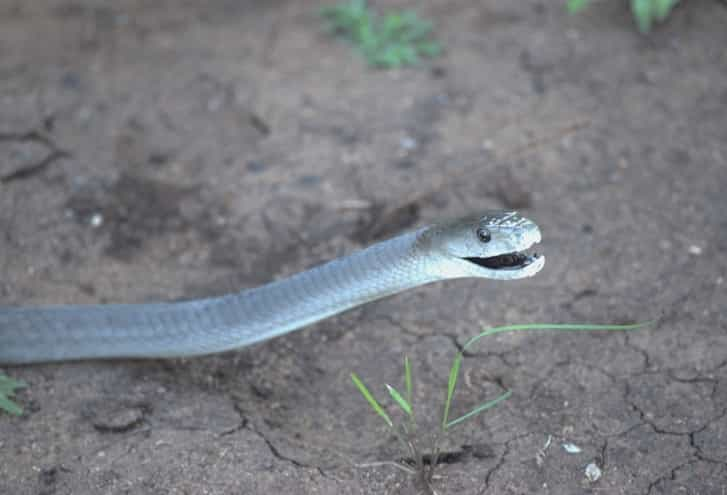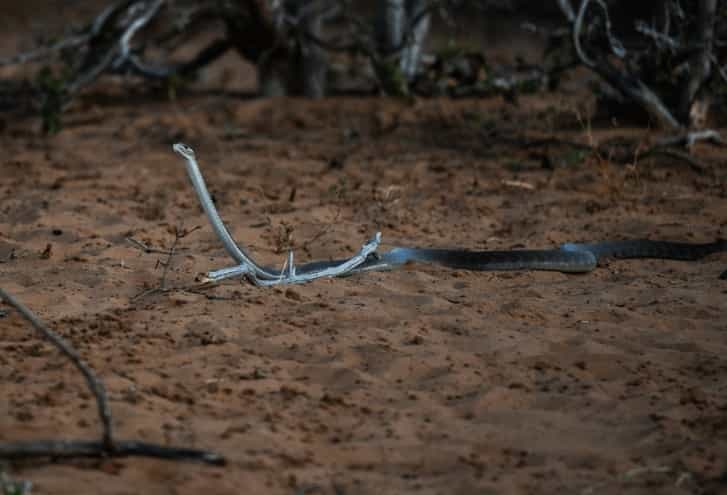Introduction

Definition of the Black Mamba
Black Mamba is a species of venomous snake that belongs to the Elapidae family. It is one of the deadliest snakes in the world, with a reputation for its highly toxic venom and aggressive behavior. The name “Black Mamba” refers to the snake’s distinctive black coloration on the inside of its mouth, as well as the dark coloration on its skin.
The scientific name for the Black Mamba is Dendroaspis polylepis, which means “many-scaled tree snake.” This name is fitting, as the Black Mamba is primarily found in trees and shrubs in sub-Saharan Africa, where it can hunt its prey and avoid predators. The Black Mamba is known for its long, slender body and its ability to move quickly and gracefully through the trees.
Black Mambas are known to be highly venomous, and their bites can be fatal to humans if left untreated. The venom of the Black Mamba attacks the nervous system, causing paralysis and respiratory failure. Despite its deadly reputation, the Black Mamba plays an important role in its ecosystem as a top predator, helping to control the populations of smaller animals.
Black Mamba is a fascinating and important species that has captured the imagination of people around the world, both for its beauty and its deadly capabilities.
Geographic range and habitat
The Black Mamba is found primarily in sub-Saharan Africa, where it inhabits a variety of different habitats. It is most found in savannas, woodlands, and rocky areas, but it can also be found in forests, swamps, and even agricultural areas.
The geographic range of the Black Mamba is vast, extending from southern and eastern Africa to as far north as Ethiopia and Somalia. Its range includes countries such as South Africa, Mozambique, Zimbabwe, Zambia, Malawi, Tanzania, Kenya, and Uganda, among others.
Within its range, the Black Mamba can be found at elevations ranging from sea level to over 2,000 meters. It is a diurnal species, which means that it is most active during the day, although it may also be active at night in certain situations.
The Black Mamba is a terrestrial species, but it is also an adept climber and can often be found in trees and shrubs. This ability to climb allows the Black Mamba to avoid predators and to hunt its prey more effectively.
Black Mamba is a highly adaptable species that can survive in a wide range of habitats and elevations. Its ability to inhabit both terrestrial and arboreal environments make it a formidable predator and an important part of its ecosystem.
Importance of the Black Mamba in its ecosystem
The Black Mamba plays an important role in its ecosystem as a top predator, helping to control the populations of smaller animals. As an ambush predator, the Black Mamba feeds primarily on small mammals, such as rodents, but it may also prey on birds, lizards, and other snakes.
By hunting and consuming these small animals, the Black Mamba helps to regulate their populations and prevent them from overgrazing or damaging the ecosystem. In this way, the Black Mamba helps to maintain a healthy balance in the ecosystem and ensures the survival of other species within its habitat.
Additionally, the Black Mamba is also an important prey species for other animals, such as birds of prey and larger predators like hyenas and jackals. By providing a food source for these animals, the Black Mamba contributes to the overall health and functioning of the ecosystem.
Black Mamba is a crucial part of the food chain in its ecosystem and plays an important role in maintaining a healthy balance of predator and prey populations. Its presence and activities contribute to the overall health and functioning of its habitat, making it a valuable and essential species in its ecosystem.
Physical Characteristics of the Black Mamba

Size and weight
Black Mamba is a large and impressive species of snake, known for its length and slender build. Adult Black Mambas can reach lengths of up to 14 feet (4.5 meters), although most individuals are typically between 8 and 10 feet (2.5-3 meters) in length. The longest recorded Black Mamba measured 14 feet 8 inches (4.5 meters) in length.
In addition to their impressive length, Black Mambas are also known for their relatively light weight, despite their size. Adult Black Mambas typically weigh between 1.5 and 4.5 pounds (0.7-2 kg), with males being slightly larger than females on average.
One of the reasons why Black Mambas can achieve such impressive lengths despite their light weight is their unique skeletal structure. Black Mambas have a relatively simple spinal structure, which allows them to be extremely flexible and agile. This flexibility is important for the Black Mamba, as it enables the snake to move quickly and gracefully through its arboreal and terrestrial environments.
The size and weight of the Black Mamba make it an impressive and formidable predator, capable of hunting and subduing a wide variety of prey. Its unique skeletal structure also makes it an incredibly agile and graceful animal, enabling it to move quickly and effectively in pursuit of its prey.
Coloration and pattern
Black Mamba is known for its distinctive coloration and pattern, which sets it apart from other species of snakes. Despite its name, the Black Mamba is not entirely black, but rather has a dark brown or olive-green coloration on its upper body, with a lighter shade of brown or gray on its underbelly.
One of the most distinctive features of the Black Mamba’s coloration is its mouth, which is black on the inside. When threatened or agitated, the Black Mamba will often open its mouth wide, displaying the dark interior and warning potential predators or threats to stay away.
In addition to its coloration, the Black Mamba also has a unique pattern of scales on its body. Its scales are small and smooth, with a shiny appearance that reflects light. The scales on its back are arranged in a distinctive pattern of irregular, chevron-shaped markings, which are light in color and often have a yellow or green tint.
Black Mamba’s coloration and pattern are a key part of its identity as a species, helping to distinguish it from other snakes and allowing it to blend into its environment. Its black mouth is also a distinctive warning sign to potential predators or threats, highlighting the deadly venom that lies within.
Unique physical features
The Black Mamba is known for its unique physical features, which enable it to be an effective predator and survive in its habitat. Here are some of the key physical features of the Black Mamba:
Long and Slender Body
The Black Mamba has a long, slender body that is designed for speed and agility. Its body is covered in smooth scales, which help it to move quickly and smoothly through its environment.
Fast and Agile
The Black Mamba is one of the fastest and most agile snakes in the world. It is capable of reaching speeds of up to 12 miles per hour (20 km/h), making it a formidable predator that is difficult to catch or escape from.
Strong and Muscular
Despite its slender build, the Black Mamba is incredibly strong and muscular. Its muscles are well-developed and powerful, enabling it to strike quickly and subdue its prey with ease.
Venomous Fangs
The Black Mamba is one of the most venomous snakes in the world, with fangs that can reach up to 6.5 mm in length. Its venom is highly toxic and can cause rapid paralysis and death in its prey.
Black Mouth
When threatened, the Black Mamba will often open its mouth wide, displaying the dark interior and warning potential predators or threats to stay away. This distinctive warning sign is a key feature of the Black Mamba’s physical appearance.
Black Mamba’s unique physical features make it a formidable predator and an important part of its ecosystem. Its speed, agility, and venomous fangs enable it to hunt and subdue a wide variety of prey, while its distinctive warning sign helps to keep potential threats at bay.
Behavior of the Black Mamba

Reproduction and mating habits
Black Mamba has a unique reproductive system, which is different from many other species of snakes. Here are some of the key facts about Black Mamba’s reproduction and mating habits:
Mating Season
The Black Mamba typically mates during the spring and summer months, when temperatures are warmer, and food is more plentiful.
Courtship Behavior
During the mating season, male Black Mambas will engage in a variety of courtship behaviors to attract a female mate. These behaviors can include approaching the female with a distinctive posture, rubbing against her body, and sometimes even engaging in physical combat with other males.
Mating
Once a male has successfully courted a female, they will mate. The mating process can take anywhere from a few minutes to several hours and involves the male using his hemipenes to transfer sperm to the female.
Gestation Period
After mating, the female Black Mamba will carry her eggs inside her body for around 60-80 days. During this time, the eggs will develop and eventually hatch inside the female’s body.
Live Birth
Unlike many other species of snakes, the Black Mamba gives birth to live young. The female will typically give birth to between 6 and 17 babies at once, which are fully formed and ready to survive on their own from the moment of birth.
Parental Care
The female Black Mamba does not provide any parental care for her young, and they are fully responsible for their own survival from the moment of birth.
Black Mamba’s reproductive system and mating habits are unique and different from many other species of snakes. Its live birth and lack of parental care make it an interesting and unusual member of the snake family.
Feeding habits and diet
Black Mamba is a carnivorous predator, and its diet is primarily made up of small mammals, birds, and reptiles. Here are some key facts about the Black Mamba’s feeding habits and diet:
Carnivorous
The Black Mamba is a carnivorous predator, meaning that it feeds exclusively on other animals. It is an opportunistic hunter and will eat whatever prey is available in its environment.
Ambush Predator
The Black Mamba is an ambush predator, meaning that it typically waits for its prey to come to it rather than actively seeking out food. It will often lie in wait in a hidden location, such as a burrow or a rock crevice, and strike quickly when prey comes near.
Primary Prey
The Black Mamba’s primary prey includes small mammals such as rodents and shrews, birds, and other reptiles such as lizards and other snakes.
Consumption Rate
The Black Mamba is a relatively large and active snake, and therefore requires a significant amount of food to sustain itself. It may consume up to one quarter of its body weight in a single feeding.
Killing Skills
The Black Mamba uses a combination of speed, stealth, and venomous fangs to hunt and subdue its prey. It will often strike multiple times to deliver a lethal dose of venom, before releasing its prey and waiting for it to die before consuming it.
Black Mamba is a skilled predator that relies on a combination of speed, stealth, and venomous fangs to hunt and subdue its prey. Its diet primarily consists of small mammals, birds, and other reptiles, and it consumes a significant amount of food in order to sustain its large and active body.
Hunting and defense mechanisms
Black Mamba is a highly skilled predator, but it also has a number of defense mechanisms that it uses to protect itself from predators and other threats. Here are some key facts about the Black Mamba’s hunting and defense mechanisms:
Hunting Techniques
The Black Mamba is a fast and agile snake, and it uses a variety of hunting techniques to capture prey. It is an ambush predator, and will often lie in wait for prey to come within striking distance before launching a rapid attack. It may also actively pursue prey, using its speed and agility to outmaneuver and catch its target.
Venom
The Black Mamba is known for its potent venom, which it uses to subdue its prey and defend itself from predators. Its venom is a potent neurotoxin that can cause respiratory failure and death in its prey. The venom is delivered through a pair of long, hollow fangs that are in the front of the snake’s mouth.
Defensive Posture
When threatened, the Black Mamba may adopt a defensive posture to deter predators. It may raise its head and neck off the ground, flatten its body, and hiss loudly to intimidate potential attackers.
Rapid Movement
The Black Mamba is one of the fastest and most agile snakes in the world, and it can move very quickly to evade predators or capture prey. It may also use rapid movements and sudden changes of direction to confuse predators and avoid attacks.
Intimidation Displays
In addition to its defensive posture and hissing, the Black Mamba may also engage in intimidation displays to deter predators. These displays may include raising its head and neck, puffing up its body, and making aggressive movements to scare off potential attackers.
Black Mamba is a highly skilled predator with several effective hunting techniques, but it also has a range of defense mechanisms that it can use to protect itself from predators and other threats. These mechanisms include its potent venom, defensive posture, rapid movement, and intimidation displays.
Interaction with Humans

Historical and cultural significance
Black Mamba has a rich history of cultural and historical significance, particularly in sub-Saharan Africa where it is found. Here are some key facts about the Black Mamba’s historical and cultural significance:
Mythology
The Black Mamba is a prominent figure in many African mythologies and folktales. In some cultures, it is seen as a powerful and fearsome creature with supernatural abilities, while in others it is a symbol of fertility, protection, or wisdom.
Traditional Medicine
The Black Mamba’s venom has long been used in traditional African medicine to treat a range of ailments, including arthritis, rheumatism, and other chronic pain conditions. However, the use of snake venom as a therapeutic agent is controversial, and there is little scientific evidence to support its efficacy.
Sports and Entertainment
The Black Mamba’s name has become synonymous with Kobe Bryant, the famous American basketball player who was nicknamed the “Black Mamba” due to his on-court intensity and skill. The name has also been used in various forms of popular culture, including films, television shows, and music.
Conservation
The Black Mamba is an important species in many African ecosystems, and its conservation is a key priority for many conservation organizations. Efforts to protect the Black Mamba and its habitat include conservation education programs, habitat restoration, and the creation of protected areas.
Tourism
The Black Mamba is a popular tourist attraction in some parts of Africa, where visitors can observe the snake in its natural habitat or at designated wildlife reserves. However, it is important to note that caution should always be exercised when interacting with wildlife, including the Black Mamba.
The Black Mamba has played an important role in the cultural, historical, and ecological landscape of sub-Saharan Africa, and its significance continues to be recognized today.
Bite and venom characteristics
The bite of the Black Mamba is one of the most feared in the world, and its venom is highly toxic. Here are some key facts about the bite and venom characteristics of the Black Mamba:
Venom
The venom of the Black Mamba is a potent neurotoxin that affects the nervous system of its prey. It is composed of a complex mixture of proteins and enzymes, including dendrotoxins, which target nerve cells, and fasciculins, which affect muscle tissue.
Toxicity
The venom of the Black Mamba is one of the most toxic of any snake species. It can cause rapid onset of symptoms such as dizziness, vomiting, abdominal pain, and respiratory distress. If left untreated, a bite from a Black Mamba can be fatal within a matter of hours.
Fangs
The Black Mamba has long, slender fangs that are in the front of its mouth. These fangs are capable of delivering a large volume of venom with each bite, and they can penetrate even thick clothing or leather.
Bite Characteristics
When the Black Mamba bites, it delivers a rapid series of bites that can cause extensive tissue damage and rapid onset of symptoms. The bite may also cause bleeding, swelling, and severe pain at the site of the bite.
Treatment
If bitten by a Black Mamba, immediate medical attention is necessary. Treatment may include antivenom, which can counteract the effects of the venom, as well as supportive care to manage symptoms and prevent complications.
The bite and venom characteristics of the Black Mamba are a significant concern for humans and other animals in its range. While the snake typically avoids contact with humans, it is important to exercise caution when in areas where the Black Mamba is known to occur.
First aid and treatment for Black Mamba bites
Seek Medical Attention Immediately
If bitten by a Black Mamba, it is crucial to seek medical attention immediately. Time is of the essence, and delaying treatment can be life-threatening.
Stay Calm and Immobilize the Affected Limb
Staying calm and keeping the affected limb immobilized can help slow the spread of venom through the body.
Remove Constricting Items
If the bite occurred on an extremity, such as an arm or leg, remove any constricting items, such as jewelry or tight clothing, to prevent swelling.
Do Not Attempt to Suck Out the Venom
Attempting to suck out the venom is not recommended, as it can be dangerous and ineffective.
Do Not Apply a Tourniquet
Applying a tourniquet is also not recommended, as it can cut off blood flow to the affected area and cause further damage.
Administer Antivenom
Antivenom is the most effective treatment for Black Mamba bites. It works by binding to the venom and neutralizing its effects. Antivenom should be administered as soon as possible by a trained medical professional.
Supportive Care
Supportive care may also be necessary to manage symptoms and prevent complications. This may include pain relief, fluid and electrolyte management, and respiratory support if necessary.
The treatment for Black Mamba bites involves prompt medical attention and administration of antivenom. It is important to follow proper first aid protocols and seek medical attention immediately if bitten by a Black Mamba.
Conservation and Future Outlook

Threats to Black Mamba populations
Habitat Loss and Fragmentation
Habitat loss and fragmentation are major threats to Black Mamba populations. As human populations expand and encroach on natural habitats, the snakes are losing their homes and becoming more vulnerable to other threats.
Hunting and Persecution
Black Mambas are often hunted and killed by humans out of fear or for their skin, meat, or other body parts. This has led to a decline in populations in some areas.
Road Mortality
Black Mambas are sometimes killed by vehicles when they crossroads or highways, which can also impact their populations.
Climate Change
Changes in climate and weather patterns can impact Black Mamba populations by altering their habitats and affecting their prey and predators.
Disease
Disease outbreaks can also impact Black Mamba populations, as well as other snake species, and can cause significant declines in numbers.
Black Mamba populations are numerous and complex. It is important to address these threats through conservation efforts, including habitat preservation, education and outreach, and policies that protect the snakes from persecution and exploitation.
Conservation efforts and success stories
Protected Areas and Habitat Conservation
Many conservation efforts for Black Mamba populations focus on protecting their natural habitats through the establishment of protected areas or conservation zones. This can help to prevent habitat loss and fragmentation and protect the snakes from other threats.
Education and Outreach
Education and outreach programs can help to raise awareness about the importance of Black Mambas and the threats they face and promote positive attitudes towards conservation. This can help to reduce hunting and persecution and promote coexistence with the snakes.
Research and Monitoring
Research and monitoring efforts can provide valuable information on Black Mamba populations and their habitat requirements, as well as inform conservation strategies and evaluate their effectiveness.
Success Stories
There are several success stories related to Black Mamba conservation efforts. For example, in South Africa, the Black Mamba Anti-Poaching Unit is a team of predominantly female rangers who use Black Mamba snakes as a conservation tool to deter poaching and protect wildlife in protected areas. This innovative approach has been successful in reducing poaching and raising awareness about conservation issues.
Black Mamba populations are ongoing and varied, and success depends on a combination of strategies and partnerships between governments, conservation organizations, local communities, and other stakeholders.
Importance of continued conservation efforts
Ecological Importance
Black Mambas play an important role in their ecosystems as top predators, regulating the populations of their prey species and maintaining the balance of their ecosystems. Losing Black Mamba populations can have cascading effects on other species and the overall health of their ecosystems.
Cultural and Historical Significance
Black Mambas have cultural and historical significance in many regions where they are found. They have been featured in traditional stories and folklore and have been used in traditional medicine and rituals. Losing Black Mamba populations can have significant cultural and historical impacts.
Economic Benefits
Conserving Black Mamba populations can also have economic benefits, such as through ecotourism or sustainable use of their resources.
Ethical Considerations
Conserving Black Mamba populations is an ethical consideration, as all species have a right to exist and contribute to the diversity of life on Earth.
Global Importance
Black Mambas are also of global importance as a species and losing them would represent a loss of biodiversity and genetic diversity on the planet.
Black Mamba populations are important to ensure the long-term survival and well-being of these important species, as well as to protect their ecosystems and the cultural and historical significance they hold.
Outline Table
| Specification | Information |
| Scientific Name | Dendroaspis polylepis |
| Common Name | Black Mamba |
| Average Length | Up to 3 meters (10 feet) |
| Average Weight | Up to 1.6 kg (3.5 pounds) |
| Geographic Range | Sub-Saharan Africa |
| Habitat | Savannas, rocky hillsides, and dense forests |
| Coloration and Pattern | Dark brown or grayish black with a lighter underbelly |
| Venom Characteristics | Neurotoxic venom that can cause rapid paralysis |
| Reproduction | Oviparous, laying eggs in clutches of up to 17 |
| Diet | Carnivorous, preying on small mammals, birds, and reptiles |
| Conservation Status | Least Concern (IUCN Red List) |
| Threats | Habitat loss, persecution by humans, and accidental encounters with people |
| Conservation Efforts | Protected under local laws, conservation education, and habitat restoration initiatives |

You forgot something!
I keep listening to the rumor speak about receiving free online grant applications so I have been looking around for the most excellent site to get one. Could you advise me please, where could i find some?